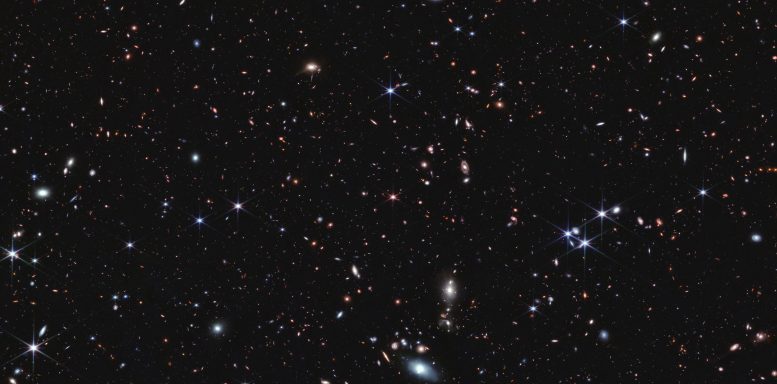
There are more than 20,000 galaxies in this field. This James Webb Space Telescope view is found between the Pisces and Andromeda constellations.
Researchers using Webb anchored their observations on quasar J0100+2802, an active supermassive black hole that acts like a beacon. It is at the center of the image above, and appears tiny and pink with six prominent diffraction spikes.
The quasar is so luminous that it acts like a flashlight, illuminating the gas between it and the telescope. The team analyzed 117 galaxies that all existed approximately 900 million years after the Big Bang – focusing on 59 that lie in front of the quasar.
Credit: NASA, ESA, CSA, Simon Lilly (ETH Zurich), Daichi Kashino (Nagoya University), Jorryt Matthee (ETH Zurich), Christina Eilers (MIT), Rob Simcoe (MIT), Rongmon Bordoloi (NCSU), Ruari Mackenzie (ETH Zurich), Alyssa Pagan (STScI), Ruari Mackenzie (ETH Zurich)
Early galaxies’ stars allowed light to travel freely by heating and ionizing intergalactic gas, clearing vast regions around them.
Cave divers equipped with brilliant headlamps often explore cavities in rock less than a mile beneath our feet. It’s easy to be wholly unaware of these cave systems – even if you sit in a meadow above them – because the rock between you and the spelunkers prevents light from their headlamps from disturbing the idyllic afternoon.
Apply this vision to the conditions in the early universe, but switch from a focus on rock to gas. Only a few hundred million years after the Big Bang, the cosmos was brimming with opaque hydrogen gas that trapped light at some wavelengths from stars and galaxies. Over the first billion years, the gas became fully transparent – allowing the light to travel freely. Researchers have long sought definitive evidence to explain this flip.
New data from the James Webb Space Telescope recently pinpointed the answer using a set of galaxies that existed when the universe was only 900 million years old. Stars in these galaxies emitted enough light to ionize and heat the gas around them, forming huge, transparent “bubbles.” Eventually, those bubbles met and merged, leading to today’s clear and expansive views.
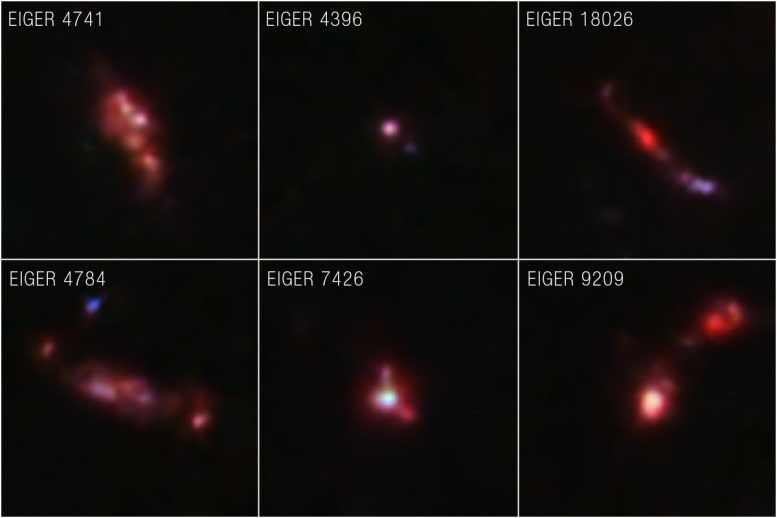
The James Webb Space Telescope has returned extraordinarily detailed images and spectra of galaxies that existed when the universe was only 900 million years old. “In Webb’s near-infrared image, we can see structures in every individual galaxy that the telescope detected,” shared Jorryt Matthee of ETH Zürich. “Webb is showing us the adventurous youth of these early galaxies.”
These galaxies look more chaotic than those in the nearby universe – they are clumpy and often elongated. These galaxies are also younger and are actively forming stars. The stars Webb detected are all more massive, which may lead to an abundance of colorful supernovae shooting off in these galaxies.
Credit: NASA, ESA, CSA, Simon Lilly (ETH Zurich), Daichi Kashino (Nagoya University), Jorryt Matthee (ETH Zurich), Christina Eilers (MIT), Rongmon Bordoloi (NCSU), Ruari Mackenzie (ETH Zurich), Alyssa Pagan (STScI), Ruari Mackenzie (ETH Zurich)
Webb Space Telescope Proves Galaxies Transformed the Early Universe
In the early universe, the gas between stars and galaxies was opaque – energetic starlight could not penetrate it. But 1 billion years after the big bang, the gas had become completely transparent. Why? New data from NASA’s James Webb Space Telescope have pinpointed the reason: The galaxies’ stars emitted enough light to heat and ionize the gas around them, clearing our collective view over hundreds of millions of years.
The results, from a research team led by Simon Lilly of ETH Zürich in Switzerland, are the newest insights about a time period known as the Era of Reionization (see image below), when the universe underwent dramatic changes. After the Big Bang, gas in the universe was incredibly hot and dense. Over hundreds of millions of years, the gas cooled. Then, the universe hit “repeat.” The gas again became hot and ionized – likely due to the formation of early stars in galaxies, and over millions of years, became transparent.
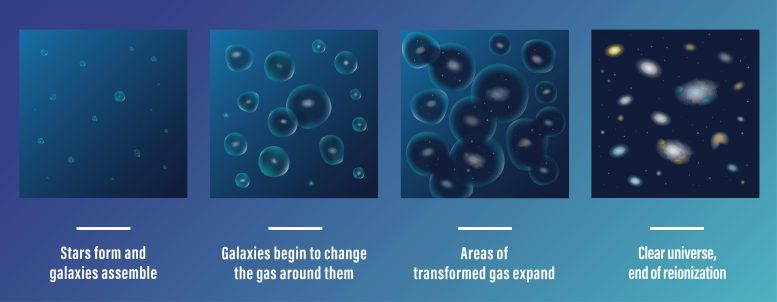
More than 13 billion years ago, during the Era of Reionization, the universe was a very different place. The gas between galaxies was largely opaque to energetic light, making it difficult to observe young galaxies. As stars and young galaxies continued to form and evolve, they began to change the gas around them. Over hundreds of millions of years, the gas converted from neutral, opaque gas to ionized, transparent gas.
What allowed the universe to become completely ionized, leading to the “clear” conditions we see in the present-day universe?
Researchers using the James Webb Space Telescope found that galaxies are overwhelmingly responsible toward the end of this period. Read about their findings.
Credit: NASA, ESA, CSA, Joyce Kang (STScI)
Researchers have long sought definitive evidence to explain these transformations. The new results effectively pull back the curtain at the end of this reionization period. “Not only does Webb clearly show that these transparent regions are found around galaxies, we’ve also measured how large they are,” explained Daichi Kashino of Nagoya University in Japan, the lead author of the team’s first paper. “With Webb’s data, we are seeing galaxies reionize the gas around them.”
These regions of transparent gas are gigantic compared to the galaxies – imagine a hot air balloon with a pea suspended inside. Webb’s data show that these relatively tiny galaxies drove reionization, clearing massive regions of space around them. Over the next hundred million years, these transparent “bubbles” continued to grow larger and larger, eventually merging and causing the entire universe to become transparent.
Lilly’s team intentionally targeted a time just before the end of the Era of Reionization, when the universe was not quite clear and not quite opaque – it contained a patchwork of gas in various states. Scientists aimed Webb in the direction of a quasar – an extremely luminous active supermassive black hole that acts like an enormous flashlight – highlighting the gas between the quasar and our telescopes. (Find it at the center of this view: It is tiny and pink with six prominent diffraction spikes.)
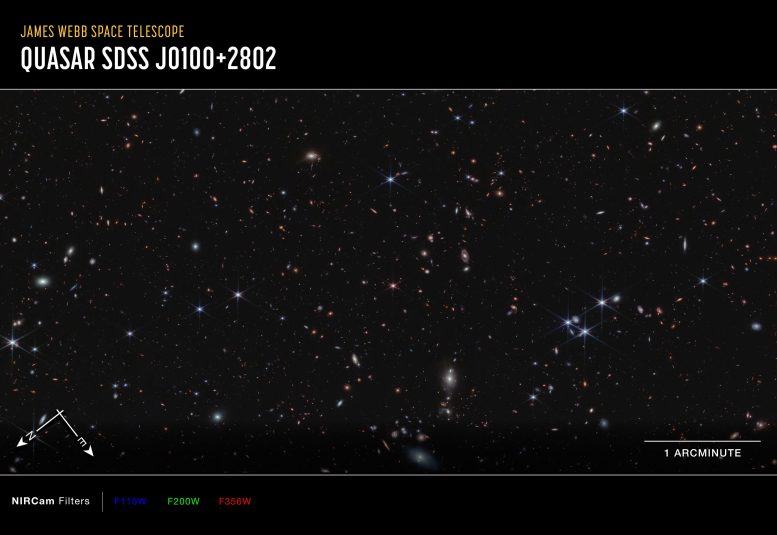
This image centered on quasar J0100+2802, captured by Webb’s NIRCam (Near-Infrared Camera), shows compass arrows, scale bar, and color key for reference.
The north and east compass arrows show the orientation of the image on the sky. Note that the relationship between north and east on the sky (as seen from below) is flipped relative to direction arrows on a map of the ground (as seen from above). The scale bar is labeled 1 arcminute.
This image shows invisible near-infrared wavelengths of light that have been translated into visible-light colors. The color key shows which NIRCam filters were used when collecting the light. The color of each filter name is the visible light color used to represent the infrared light that passes through that filter. In this image, blue, green, and red were assigned to NIRCam data at 1.15, 2, and 3.65 microns (F115W, F200W, and F365W), respectively.
Credit: NASA, ESA, CSA, Simon Lilly (ETH Zurich), Daichi Kashino (Nagoya University), Jorryt Matthee (ETH Zurich), Christina Eilers (MIT), Rob Simcoe (MIT), Rongmon Bordoloi (NCSU), Ruari Mackenzie (ETH Zurich), Alyssa Pagan (STScI), Ruari Mackenzie (ETH Zurich)
As the quasar’s light traveled toward us through different patches of gas, it was either absorbed by gas that was opaque or moved freely through transparent gas. The team’s groundbreaking results were only possible by pairing Webb’s data with observations of the central quasar from the W. M. Keck Observatory in Hawaii, and the European Southern Observatory’s Very Large Telescope and the Magellan Telescope at Las Campanas Observatory, both in Chile.
“By illuminating gas along our line of sight, the quasar gives us extensive information about the composition and state of the gas,” explained Anna-Christina Eilers of MIT in Cambridge, Massachusetts, the lead author of another team paper.
The researchers then used Webb to identify galaxies near this line of sight and showed that the galaxies are generally surrounded by transparent regions about 2 million light-years in radius. In other words, Webb witnessed galaxies in the process of clearing the space around them at the end of the Era of Reionization. To put this in perspective, the area these galaxies have cleared is approximately the same distance as the space between our Milky Way galaxy and our nearest neighbor, Andromeda.
Until now, researchers didn’t have this definitive evidence of what caused reionization – before Webb, they weren’t certain precisely what was responsible.
What do these galaxies look like? “They are more chaotic than those in the nearby universe,” explained Jorryt Matthee, also of ETH Zürich and the lead author of the team’s second paper. “Webb shows they were actively forming stars and must have been shooting off many supernovae. They had quite an adventurous youth!”
Along the way, Eilers used Webb’s data to confirm that the black hole in the quasar at the center of this field is the most massive currently known in the early universe, weighing 10 billion times the mass of the Sun. “We still can’t explain how quasars were able to grow so large so early in the history of the universe,” she shared. “That’s another puzzle to solve!” The exquisite images from Webb also revealed no evidence that the light from the quasar had been gravitationally lensed, ensuring that the mass measurements are definitive.
The team will soon dive into research about galaxies in five additional fields, each anchored by a central quasar. Webb’s results from the first field were so overwhelmingly clear that they couldn’t wait to share them. “We expected to identify a few dozen galaxies that existed during the Era of Reionization – but were easily able to pick out 117,” Kashino explained. “Webb has exceeded our expectations.”
Lilly’s research team, the Emission-line galaxies and Intergalactic Gas in the Epoch of Reionization (EIGER), has demonstrated the unique power of combining conventional images from Webb’s NIRCam (Near-Infrared Camera) with data from the same instrument’s wide-field slitless spectroscopy mode, which gives a spectrum of every object in the images – turning Webb into what the team calls a “spectacular spectroscopic redshift machine.”
The team’s first publications include “EIGER I. a large sample of [O iii]-emitting galaxies at 5.3 < z < 6.9 and direct evidence for local reionization by galaxies,” led by Kashino, “EIGER II. first spectroscopic characterisation of the young stars and ionised gas associated with strong Hβ and [OIII] line-emission in galaxies at z = 5 – 7 with JWST,” led by Matthee, and “EIGER III. JWST/NIRCam observations of the ultra-luminous high-redshift quasar J0100+2802,” led by Eilers, and were published in The Astrophysical Journal.
References:
“EIGER. I. A Large Sample of [O iii]-emitting Galaxies at 5.3 < z < 6.9 and Direct Evidence for Local Reionization by Galaxies” by Daichi Kashino, Simon J. Lilly, Jorryt Matthee, Anna-Christina Eilers, Ruari Mackenzie, Rongmon Bordoloi and Robert A. Simcoe, 12 June 2023, The Astrophysical Journal.
DOI: 10.3847/1538-4357/acc588
“EIGER. II. First Spectroscopic Characterization of the Young Stars and Ionized Gas Associated with Strong Hβ and [O iii] Line Emission in Galaxies at z = 5–7 with JWST” by Jorryt Matthee, Ruari Mackenzie, Robert A. Simcoe, Daichi Kashino, Simon J. Lilly, Rongmon Bordoloi and Anna-Christina Eilers, 12 June 2023, The Astrophysical Journal.
DOI: 10.3847/1538-4357/acc846
“EIGER. III. JWST/NIRCam Observations of the Ultraluminous High-redshift Quasar J0100+2802” by Anna-Christina Eilers, Robert A. Simcoe, Minghao Yue, Ruari Mackenzie, Jorryt Matthee, Dominika Ďurovčíková, Daichi Kashino, Rongmon Bordoloi and Simon J. Lilly, 12 June 2023, The Astrophysical Journal.
DOI: 10.3847/1538-4357/acd776
The James Webb Space Telescope is the world’s premier space science observatory. Webb will solve mysteries in our solar system, look beyond to distant worlds around other stars, and probe the mysterious structures and origins of our universe and our place in it. Webb is an international program led by NASA with its partners, ESA (European Space Agency) and the Canadian Space Agency.

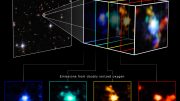
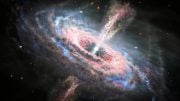
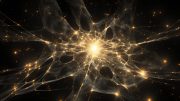
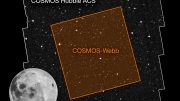

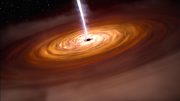
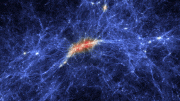
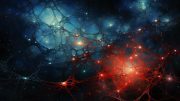
Awe inspiring super visuals don’t forget to knock on God’s door!!!!???
Achill
Thank you 🙏💕